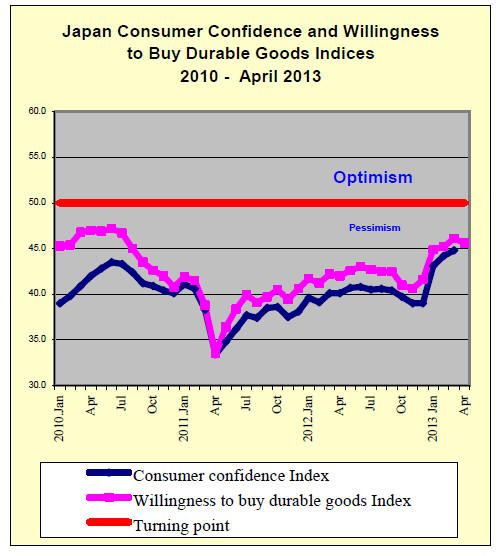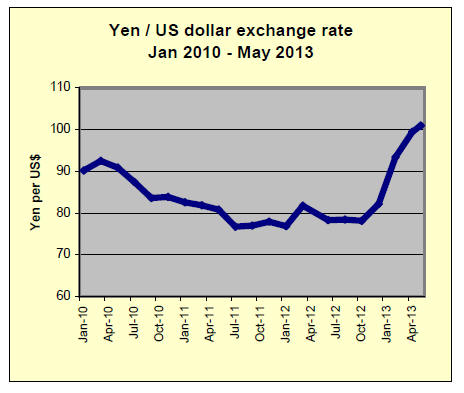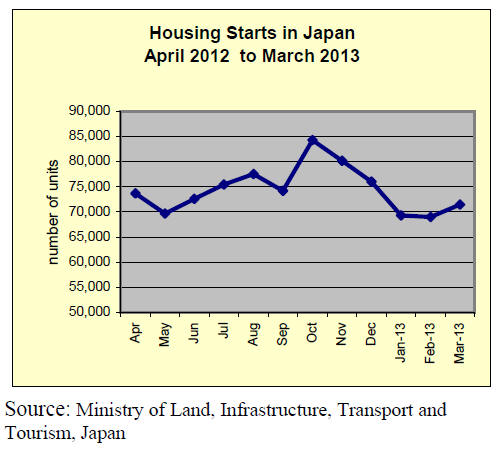Japan Wood Products
Prices
Dollar Exchange Rates of
10th May 2013
Japan Yen
101.60
Reports From Japan
Consumer confidence unexpectedly slides
The Cabinet Office released the latest Confidence Index for Japanese
consumers. Unexpectedly the latest results show that consumer confidence has
slipped since the March survey.
The seasonally adjusted consumer confidence index fell to 44.5 in April from
44.8 in March. The index of willingness to buy durable goods also declined.
Analysts had expected the index to continue to improve and were forecasting
an index level of over 45 for April.

Cabinet Office claims improvement in economy
The Japan Monthly Economic Report from the Cabinet Office provides a summary
of the economic outlook. See: Executive Summary (Apr 2013)
http://www5.cao.go.jp/keizai3/getsurei-e/2013apr.html.
The report says the Japanese economy is showing signs of picking up but
weakness remains in some areas. The positive signs are that:
exports are levelling off
industrial production is showing signs of improvement
corporate profits show signs of improvement, mainly among large firms
business investment is levelling off
business sentiment shows signs of improvement
the employment situation shows signs of improvement but some severe
aspects still remain
private consumption is picking up
Recent price developments indicate that the Japanese economy is still in a
mild deflationary phase.
In the short-term prospects for recovery are expected to improve gradually,
supported by an improvement in corporate and public confidence driven by a
stronger export performance and the impact of the government stimulus
package and new monetary policy. However, weak overseas demand remains a
downside risk for the Japanese economy.
Private consumption picking up
Private consumption is picking up according to the monthly report. One of
the factors behind this is that while real incomes remain broadly flat,
consumer confidence is improving.
In the short-term private consumption is expected to continue to strengthen
however, employment levels and income growth, or lack thereof, must be
carefully monitored.
Signs of improvement in business investment
Business investment, which has been severely dampened by the current state
of the domestic and global economy, is starting to level off.
The quarterly financial statements of corporations suggest that business
investment increased for the first time in four quarters. In the October -
December quarter of 2012, investment by manufacturers fell but increased for
non-manufacturers.
G7 accepts yen exchange rate not being manipulated
On foreign exchange markets the yen fell to a four year low against the US
dollar on May 9. An exchange rate of 101 yen to the dollar marked a turning
point for the yen as the government’s stimulus measures and the Bank of
Japan’s efforts to expand liquidity start to have a greater impact.
The trigger for the yen to break the 100 yen to the dollar mark seems to
have been in response to the improved US jobless claims reported on May 3
showing that first-time unemployment numbers fell to the lowest level since
January 2008.
This news, coming on top of suggestions that the Federal Reserve may begin
unwinding its quantitative easing schedule as early as June this year,
altered the outlook in the yen:dollar currency markets. Many analysts
believe a new round of yen weakness will now set in.

At the recent G7 meeting of representatives from members - the U.S.,
Germany, France, Italy, Japan, Canada and the U.K steered clear of
discussions of ‘currency wars’ instead focused on how each member should put
in place policies balancing austerity measures with growth-enhancing
measures.
Prior to the meeting there was concern in Japan that the government’s
aggressive monetary easing, which has resulted in a sharp weakening of the
yen, would attract criticism. However the sentiment expressed after the G7
meeting seemed to provide support for the policies adopted by the Japanese
government and this could pave the way for a further weakening of the yen.
Trade news from the Japan Lumber Reports (JLR)
The Japan Lumber Reports (JLR), a subscription trade journal published every
two weeks in English, is generously allowing the ITTO Tropical Timber Market
Report to extract and reproduce news on the Japanese market.
The JLR requires that ITTO reproduces newsworthy text exactly as it appears
in their publication.
For the JLR report please see:
http://www.n-mokuzai.com/modules/general/index.php?id=7
March new housing starts
March starts were 71,456 units, 7.3% more than March last year, seven
consecutive months increase. Owners units and rental units recorded double
digit increase.
Seasonally adjusted annual starts were 904,000 units, 4.2% less than
February because of decline of condominium starts.
This seems to be temporary drop and the Ministry of Land, Infrastructure and
Transport commented housing market continues gradual recovery. In March
starts, owners’ units showed 11.4% more and rental units 10.7% more. Owners’
units increased in populated regions like Tokyo and Nagoya then starts in
three quake stricken prefectures of Iwate, Miyagi and Fukushima were
considerably high.

Meantime, in units built for sale, condominium starts were down because
of high starts in February but detached units increased for seven
consecutive months and maintained more than 10,000 units level since last
June.
Wood based units were 39,637, 11.3% more with the share of 55.5%, 3.7 points
up from February.
Movement of plywood is getting stable after excitement is fading.
Inquiries in domestic softwood plywood are slowing by dealers. In the first
quarter, wholesalers and retailers built up inventories in speculation but
actual demand did not appear as expected so the inventory depletion is not
progressing.
March was busy month as order balances of January and February were
delivered all at one time then the shipment was high with 218,900 cbms so
compared to March, April was quiet month. However, the shipment by the
manufacturers continues high for precutting plants and house builders.
Considering low level inventory of 125,000 cbms, some are building inventory
as the supply shortage may occur again once the demand takes off. Thus, the
manufacturers are bullish and plan to increase the sales prices in May
again.
In Tokyo regional market, the prices of JAS 12 mm 3x6 are 890-900 yen per
sheet delivered, 20-30 yen up from April. 1,790 yen on 24 mm thick panel, 50
yen up. 1,350 yen on 9 mm 3x10 long panel, 50 yen up.


On imported plywood, supplying mills suffer log shortage and high log
cost in Malaysia and Indonesia so that export prices continue climbing but
the market in Japan is slow to follow by lack of demand. Dealers’
inventories are still high so that they are not able to buy future cargoes.
The supply side plans to increase the export prices again in May but the
prices in Japan are slow to go up. Suppliers’ price increase is too much too
fast so that the Japanese buyers are beginning to lose interest and the
future purchase volume has been declining since last February.
In Tokyo market, the prices of 3x6 JAS concrete forming panel are 1,100
yen per sheet delivered, 20 yen up from April. 12 mm structural panel are
1,150 yen, 50 yen up. JAS 3x6 coated concrete forming panel are1,200 yen, 20
yen up.
TPP participation and reaction by Japanese forest industry
Japan has been expressing intention to participate TPP (Trans Pacific
Partnership) and there are pro and con in Japan regarding the participation.
The National Federation of Forest Owners Cooperative Association recently
met the Minister of Agriculture, Forestry and Fisheries and expressed the
comment of the
Association. The Association held the general meeting in late March and made
up the resolution regarding participation of TPP.
The Association handed the resolution to the Minister. The resolution says
that it is necessary to take maximum consideration of maintaining import
duty on plywood and
lumber, which is indispensable for maintaining forest industry and for
taking measures preventing global warming.
It fears participation may trigger further deterioration of forest and
forest industry by free trade. Also the Committee on Agriculture, Forestry
and Fisheries passed the resolution in April 19, which says that important
items of agriculture such as rice, wheat, beef, pork, dairy products and
sugar cane are excluded from the negotiation or should be renegotiated
later.
Abolition of the import duty is not conceded including gradual abolition
over ten years. It also includes the same resolution as the Forest Owners
Association’s resolution of maintaining the duty on plywood and certain kind
of lumber.
On April 29, Canada agreed to let Japan in for TPP so all of eleven
countries now support participation of Japan. After approval by U.S.
congress, Japan will join the TPP Japan has been expressing intention to
participate TPP (Trans Pacific Partnership) and there are pro and con in
Japan regarding the participation.
The National Federation of Forest Owners Cooperative Association recently
met the Minister of Agriculture, Forestry and Fisheries and expressed the
comment of the
Association.
The Association held the general meeting in late March and made up the
resolution regarding participation of TPP.
The Association handed the resolution to the Minister. The resolution says
that it is necessary to take maximum consideration of maintaining import
duty on plywood and
lumber, which is indispensable for maintaining forest industry and for
taking measures preventing global warming. It fears participation may
trigger further deterioration of forest and forest industry by free trade.
Also the Committee on Agriculture, Forestry and Fisheries passed the
resolution in April 19, which says that important items of agriculture such
as rice, wheat, beef, pork, dairy products and sugar cane are excluded from
the negotiation or should be renegotiated later.
Abolition of the import duty is not conceded including gradual abolition
over ten years. It also includes the same resolution as the Forest Owners
Association’s resolution of maintaining the duty on plywood and certain kind
of lumber.
On April 29, Canada agreed to let Japan in for TPP so all of eleven
countries now support participation of Japan. After approval by U.S.
congress, Japan will join the TPP meeting in late July.
|